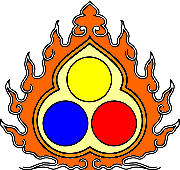Buddha, Dharma, Sangha and Taking Refuge

The Three Jewels
The Three Jewels are the Buddha, the Dharma, and the Sangha.
The Buddha is someone who has purified their mind of all impurities and has developed all positive qualities. Impurities refer to anything that harms ourselves and others: negative (disturbing) emotions, the imprints of actions driven by these emotions, and the consequences of these emotions. Positive qualities refer to all qualities that bring happiness to ourselves and others, such as unconditional love and compassion, boundless wisdom, and the ability to help others.
The Dharma refers to both the teachings of the Buddha and the realizations you can develop through them. The Buddha's teachings show us ways to prevent problems and suffering. Realizations of that teaching mean not just having knowledge of the teachings, but actually being able to stop problems and their causes.
The Sangha strictly consists of individuals who possess direct, non-conceptual insight into the ultimate truth of emptiness (Aryas). Sangha is often used to refer to monks and nuns, and in general Western usage, it can also refer to the entire community of Buddhists (lay and ordained).
Taking Refuge
Taking refuge means trusting with all your heart that the Three Jewels inspire you and lead your life in a constructive and positive direction. Taking refuge can also be seen as 'becoming Buddhist'. This is a completely personal decision, and you don't need anyone else for it. To make it more formal, you can take refuge with a spiritual teacher through a short ritual. Usually, you also receive a Buddhist name and take some vows.
The Dharma is our true refuge, like the medicine we take that alleviates our problems and their causes.
The Buddha is like the doctor who correctly diagnoses the cause of our problems and prescribes the necessary medicine.
The Sangha guides us in our practices, like the nurse who helps us take the medicine. In the context of taking refuge, the most strict definition of individuals with direct realizations of emptiness (Aryas) is referred to.
Different traditions may vary in the vows you can or should take when taking refuge; the following description is from Tibetan Buddhism. As a minimum vow, you pledge not to harm sentient beings. Additionally, you can take one or more of the following vows:
- Not to kill. This includes not only killing humans but all sentient beings, including fish and insects.
- Not to steal: taking what is not freely given.
- Not to lie.
- No sexual misconduct, such as committing adultery or sexual abuse.
- Not to use intoxicants, such as alcohol and drugs.
Lay vows are taken for the rest of this life. It's advisable to think carefully beforehand and inquire with your teacher about the obligations. Taking refuge also creates a special karmic bond with the teacher, and it's important to investigate whether the teacher is not a charlatan.
Taking refuge does not mean we can passively hide behind the protection of the Buddha, the Dharma, and the Sangha. It is rather an active process of following the path they show, and in doing so, improving the quality of our lives and those of others.
See the next page for: Four Noble Truths - the basis of Buddhism.